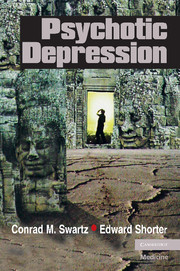Book contents
- Frontmatter
- Contents
- Preface
- Acknowledgments
- Chapter 1 Introduction
- Chapter 2 History of Psychotic Depression
- Chapter 3 Diagnosis in Psychotic Depression
- Chapter 4 Patients' Experience of Illness
- Chapter 5 Treatment in Historical Perspective
- Chapter 6 Treatment: Pitfalls and Pathways
- Chapter 7 Treatment: ECT, Medications, and More
- Chapter 8 Treatment by Type of Psychotic Depression
- Appendix 1 Summary Guide to Psychiatric Concepts
- Appendix 2 Summary Guide to Psychotropic Medication and Treatment
- References
- Index
Chapter 2 - History of Psychotic Depression
Published online by Cambridge University Press: 10 September 2009
- Frontmatter
- Contents
- Preface
- Acknowledgments
- Chapter 1 Introduction
- Chapter 2 History of Psychotic Depression
- Chapter 3 Diagnosis in Psychotic Depression
- Chapter 4 Patients' Experience of Illness
- Chapter 5 Treatment in Historical Perspective
- Chapter 6 Treatment: Pitfalls and Pathways
- Chapter 7 Treatment: ECT, Medications, and More
- Chapter 8 Treatment by Type of Psychotic Depression
- Appendix 1 Summary Guide to Psychiatric Concepts
- Appendix 2 Summary Guide to Psychotropic Medication and Treatment
- References
- Index
Summary
In psychiatry, the past can be a storehouse of wisdom. Very often the older diagnoses and remedies are superior to the newer patent-protected drugs and industry-promoted diagnoses. It is for that reason that some understanding of the history and diagnosis of psychotic depression is useful.
We know historically that psychotic depression seems to have a specific response to treatment and a specific prognosis. That matters today. If you as a physician did not have a distinctive treatment to offer, it would not matter so much whether psychotic depression differs from other illnesses, just an academic exercise, really. But here therapeutic choices exist. Also, there are different kinds of psychotic depression, with different responses to treatment (see Chapter 8). Finally, you can tell a troubled family what they can expect in the future. So these diagnostic hairsplittings are not academic.
Psychiatry has long yearned for such choices. As Robert Gaupp, professor of psychiatry in Tübingen, said in 1926:
What we want and need as physicians are diagnoses and classifications that don't let us down when we're in front of a living human being, a human being who stands ill before us and whose apprehensive family wants to know what's going to happen, recovery or chronic suffering, return to normality or death after years or decades of decline. What's going to happen? What should we do?”
(Gaupp, 1926; emphasis in the original)So chiseling psychotic depression from the mass of undifferentiated depressive illness is quite a practical exercise.
- Type
- Chapter
- Information
- Psychotic Depression , pp. 21 - 58Publisher: Cambridge University PressPrint publication year: 2007



